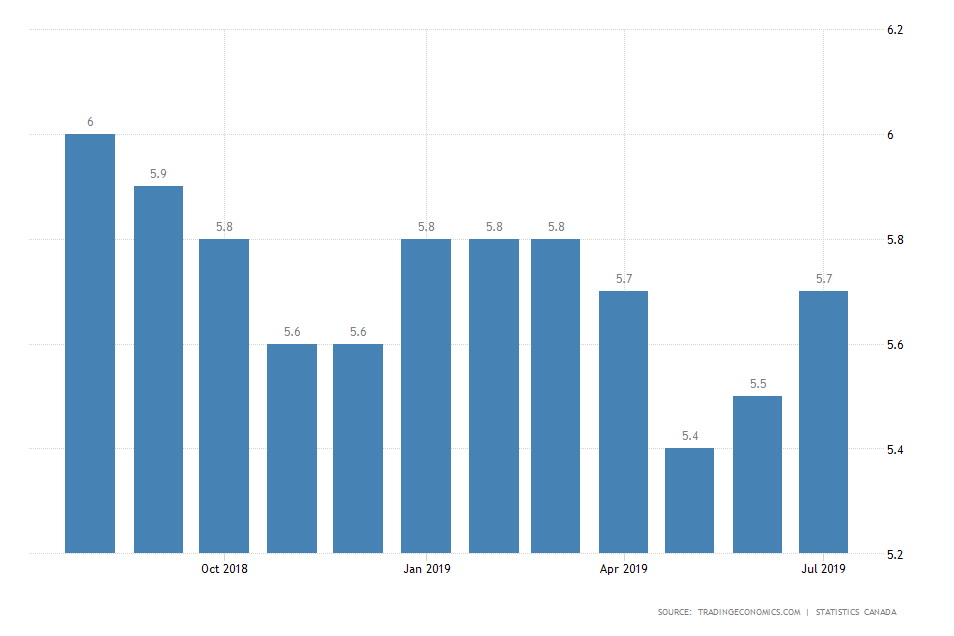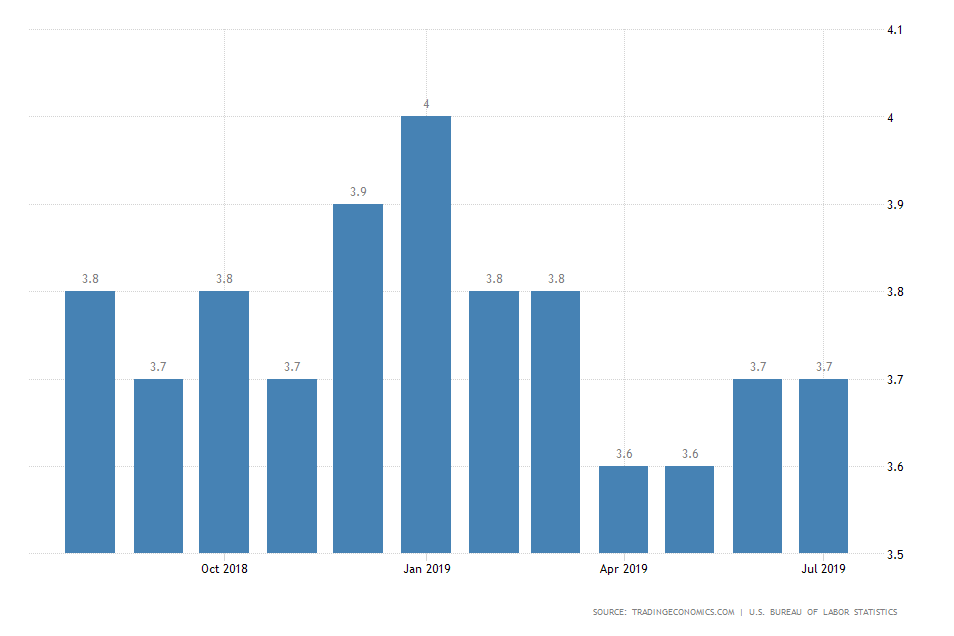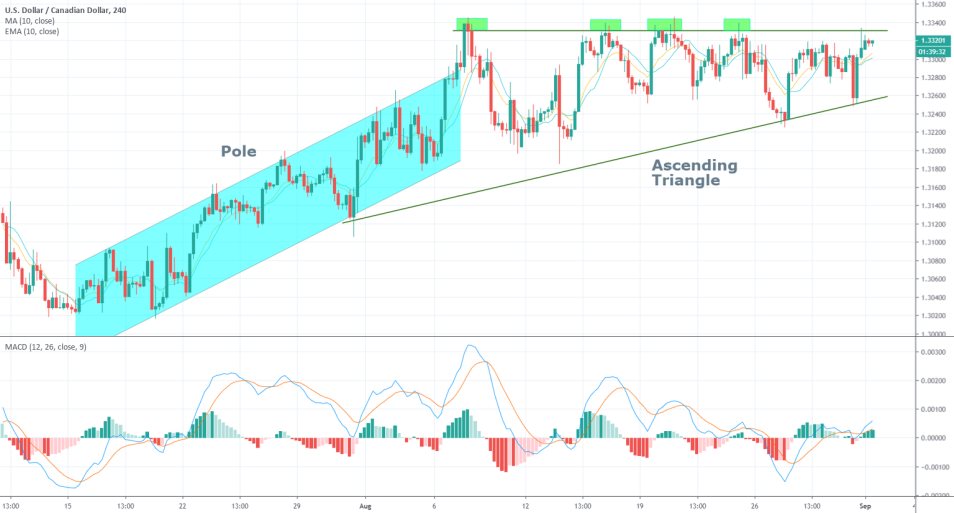
The two most significant economic events for the week ahead will be the Non-Farm Payrolls in the United States and the Unemployment Report in Canada, both scheduled for Friday. The two countries will release their respective economic findings simultaneously at 12.30pm CET, which means that heightened volatility can be expected for the USDCAD pair around noon on Friday.
In Canada, the unemployment rate has risen with 0.1 per cent in June from the recorded 5.4 per cent rate in the previous month, and the overall unemployment has appreciated with an additional 0.2 per cent in July. Thus, the Canadian economy has experienced two consecutive months of gradually increasing unemployment, which could become potentially start worrying local investors if Friday’s report demonstrates that the trend has been maintained throughout August as well.

Should the unemployment rate rise to 5.8 per cent or above, the Bank of Canada would have to reconsider its monetary policy and perhaps even weigh in on a potential rate cut, as the economy would be transitioning away from a status of full employment.
As regards the United States, the unemployment remained unchanged last month at 3.7 per cent, and the labour market is still exhibiting resilience currently operating at close to full employment. However, revisions of past Non-Farm Payrolls reports demonstrate that ‘employment gains in May and June combined were 41 000 less than previously reported’ [source] . Thus, the average monthly job gains for the past three months have been estimated to be at 140 000, and if Friday's NFP reports fewer new jobs to have been created in August, the US dollar could be weakened as a result of the report's sluggish outlook.

As per usual the NFP data will be closely scrutinized by the FED as it is an essential measurement of the underlying monetary policy's effectiveness, and should the labour market exhibit early signs of moving away from full-employment, the FOMC might be inclined to consider further interventions by the end of 2019.
Moreover, Jerome Powell is scheduled to deliver a speech on Friday following the release of the NFP report, and his commentary is expected to focus at least partially on the labour market conditions in the country and any possible interest rate alterations by the end of the year.
Overall, the USDCAD is currently forming an ascending triangle formation on the 4H chart, and the momentum is temporarily looking stagnant; however, the condition of this low-volatility environment should be broken once the momentum starts to build up once again. Friday's simultaneous release of the two countries' unemployment data could trigger one such volatility outburst, which could, in turn, cause the momentum to pick up and break this low-volatility environment.

Trendsharks Premium
Gold is undergoing a correction, as investors take profits to offset losses from falling stock prices, impacting their margins. However, we anticipate a renewed wave of [...]
The Swiss stock market index is mirroring its global counterparts, such as Germany 40 and US100, experiencing a sharp decline following the announcement of new [...]
We’re analyzing the weekly chart to grasp the broader market trend. Over the past three years, the US30 index has surged by 17,000 points, often resembling a nearly straight [...]
Over the past week, the DAX has experienced a sharp decline, plunging by an astonishing 3,400 points. This downward movement is not isolated, as its international counterparts, such as the UK100 and US100, are also facing significant [...]
EURUSD recently formed a double top at 1.0930, signaling a potential trend reversal, and has since begun a correction. After a 600-pip rally since early March, a pullback at this stage is both expected and healthy. Given these conditions, we are placing a [...]
Since early March, EURJPY has surged nearly 1,000 pips, providing us with several excellent trading opportunities. However, as the rally matures, many early buyers are beginning to take profits, leading to a noticeable slowdown in the uptrend. On Friday, the pair formed a [...]
The AUDJPY currency pair continues to be dominated by bullish momentum, as multiple golden cross patterns reaffirm the strength of the ongoing uptrend. Despite this, we are witnessing a much-needed [...]
The EURAUD currency pair appears to be undergoing a trend reversal, signaling a potential shift in market direction. A notable technical development is the formation of a Death Cross on the chart, a widely recognized bearish indicator that typically suggests a [...]
After securing an impressive 200-pip profit last week, the EURJPY currency pair is now undergoing a southward correction, retracing some of its recent gains. Despite this temporary pullback, the Golden Cross remains intact, reinforcing our view that the overall trend continues to be [...]
The appearance of a Golden Cross in Silver strengthens our analysis that the metal is currently in a strong uptrend, indicating further bullish momentum in the market. This technical pattern, where the short-term moving average crosses above the [...]
This trade presents a considerable level of risk and can be classified as an opportunistic move based on recent price action. The GBPUSD currency pair has experienced a substantial bullish rally, surging by nearly 500 pips in a strong upward movement. However, after this extended period of appreciation, the pair is showing signs of a potential [...]
The anticipated Death Cross on the SMI20 appears to be failing as price finds strong support at the 23% Fibonacci retracement level. After testing this area, the index has shown bullish strength, printing several large green candles, signaling an increase in [...]
A Golden Cross has just appeared on the USDJPY chart, signaling a potential bullish move. This technical pattern occurs when the 20 period moving average crosses above the 60 period moving average, a widely recognized indication of increasing [...]
After 2 months of a down trend, we finally see some indications of price recovery for Oil. The golden cross, a historic buy signal, supports this [...]
For the past month, the German DAX40 has experienced a remarkable 10% surge, reflecting strong bullish momentum. Despite ongoing market volatility and frequent pullbacks, every dip continues to attract fresh buyers, reinforcing the [...]
Oil continues its downward trajectory, despite occasional pullbacks. The overall trend remains bearish, reinforced by multiple Death Cross patterns, a classic sell signal indicating further weakness. Adding to this bearish outlook, the critical [...]
Over the past few days, gold has experienced a sharp decline of more than $100. This downturn can be attributed in part to traders securing profits to manage their margins, which are under strain due to the significant drop in major indices. Currently, gold has fallen below the [...]
The NASDAQ 100 index is showing strong bullish momentum, as evidenced by the formation of a Golden Cross on the chart. This classic buy signal occurs when the short moving average crosses above the long term moving average, suggesting that upward momentum is [...]
The EURAUD currency pair has encountered a significant resistance level, failing to break above the critical 61% Fibonacci retracement level. This suggests that bullish momentum is weakening, reinforcing the case for a potential downward move. Given this technical setup, we favor entering a [...]
The UK100 is experiencing a remarkable rally! Over the past few weeks, the British stock market index has surged nearly 800 points. Each minor dip has attracted more buyers, fueling the bullish momentum. However, since last week, we’ve observed a slight [...]




















